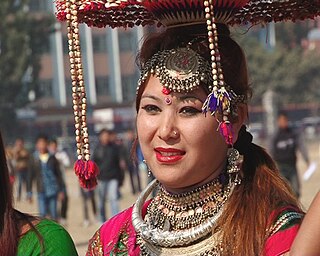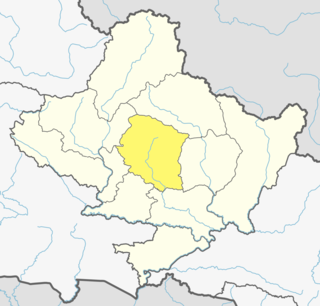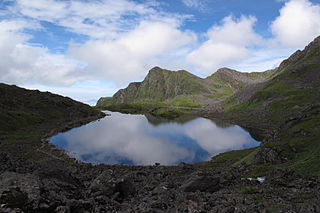Related Research Articles
Dura is a recently extinct language of Nepal. It has been classified in the West Bodish branch of Tibetan languages, though more recent work separates it out as an independent branch of Sino-Tibetan. Many of the Dura have switched to speaking Nepali, and the Dura language has sometimes been thought to be extinct. Some of the people who have switched to Nepali for their daily speech still use Dura for prayer.

The Tharu people are an ethnic group indigenous to the Terai in southern Nepal and northern India. They speak Tharu languages. They are recognized as an official nationality by the Government of Nepal. In the Indian Terai, they live foremost in Uttarakhand, Uttar Pradesh and Bihar. The Government of India recognizes the Tharu people as a scheduled tribe.

Bhanubhakta Acharya was a Nepali writer, poet, and translator. He is widely regarded as the first poet in the Nepali language, for which he was conferred with the title of "Aadikabi": literally, "the first poet".
Indo-Pakistani Sign Language (IPSL) is the predominant sign language in the subcontinent of South Asia, used by at least 15 million deaf signers. As with many sign languages, it is difficult to estimate numbers with any certainty, as the Census of India does not list sign languages and most studies have focused on the north and urban areas. As of 2021, it is the most used sign language in the world, and Ethnologue ranks it as the 151st most "spoken" language in the world.

Kaski District, a part of Gandaki Province, is one of the seventy-seven districts of Nepal. The name is disambiguated from Kaskikot, the ancient Kaski Kingdom.

Lamjung District, a part of Gandaki Province, is one of the 77 districts of Nepal. The district, with Besisahar as its district headquarters, covers an area of 1,692 square kilometres (653 sq mi) and as of 2011 had a population of 167,724. Lamjung lies in the mid-hills of Nepal spanning tropical to trans-Himalayan geo-ecological belts, including the geographical midpoint of the country. It has mixed habitation of casts and ethnicities. It is host to probably the highest density of the Gurung ethnic population in the country.

Ramechhap District, a part of Bagmati Province, is one of the seventy-seven districts of Nepal, a landlocked country of South Asia. The district, known as wallo Kirat Ramechhap, with Manthali as its district headquarters, covers an area of 1,546 km2 (597 sq mi) and has a population (2011) of 202,646 and a density of 137.4 per km2.

Sunuwar, Sunuwar, or Kõinch, is a Kiranti language spoken in Nepal and India by the Sunuwar people. It was first comprehensively attested by the Himalayan Languages Project. It is also known as Kõits Lo, Kiranti-Kõits, Mukhiya.

Languages of Nepal constitutionally called Nepalese languages are the languages having at least an ancient history or origin inside the sovereign territory of Nepal spoken by Nepalis. The 2011 national census lists 123 languages spoken as a mother tongue in Nepal. Most belong to the Indo-Aryan and Sino-Tibetan language families.
The 1991 Nepal census was a widespread national census conducted by the Nepal Central Bureau of Statistics.
The Hyolmo are a people mainly from the Eastern and Northern Himalayan Regions of Nepal. They refer to themselves as the "hyolmo" or "Yolmopa" and are native residents of the Helambu valleys and the surrounding regions of Northeastern Nepal. Their combined population in these regions is around 11,000. They also have sizeable communities in Bhutan, Darjeeling, Sikkim and some regions of South-Western Tibet. They are among the 59 indigenous groups officially recognized by the Government of Nepal as having a distinct cultural identity and are also listed as one of the 645 Scheduled Tribes of India.
Nepalese Sign Language or Nepali Sign Language is the main sign language of Nepal. It is a partially standardized language based informally on the variety used in Kathmandu, with some input from varieties from Pokhara and elsewhere. As an indigenous sign language, it is not related to oral Nepali. The Nepali Constitution of 2015 specifically mentions the right to have education in Sign Language for the deaf. Likewise, the newly passed Disability Rights Act of 2072 BS defined language to include "spoken and sign languages and other forms of speechless language." in practice it is recognized by the Ministry of Education and the Ministry of Women, Children and Social Welfare, and is used in all schools for the deaf. In addition, there is legislation underway in Nepal which, in line with the UN Convention on the Rights of Persons with Disabilities (UNCRPD) which Nepal has ratified, should give Nepalese Sign Language equal status with the oral languages of the country.
Jumla Sign Language is a village sign language of the town of Jumla in western Nepal. There is a Nepalese Sign Language school in Jumla, and that the students come from a 1–2-day walk away and do not speak Jumla Sign Language.
Ghandruk Sign Language is a village sign language of the village of Ghandruk in central Nepal.
Rawat (Raute), or "Jangali" (Jungle), is a small Sino-Tibetan language of India. It is spoken in 9 villages north of Askot in Pithoragarh district, Uttarakhand, India (Ethnologue) as well as in several villages in Dadeldhura District, Nepal and Darchula District, Nepal.
A village sign language, or village sign, also known as a shared sign language, is a local indigenous sign language used by both deaf and hearing in an area with a high incidence of congenital deafness. Meir et al. define a village sign language as one which "arise[s] in an existing, relatively insular community into which a number of deaf children are born." The term "rural sign language" refers to almost the same concept. In many cases, the sign language is known throughout the community by a large portion of the hearing population. These languages generally include signs derived from gestures used by the hearing population, so that neighboring village sign languages may be lexically similar without being actually related, due to local similarities in cultural gestures which preceded the sign languages. Most village sign languages are endangered due to the spread of formal education for the deaf, which use or generate deaf-community sign languages, such as a national or foreign sign language.
Nepal conducted a widespread national census in 2011 by the Nepal Central Bureau of Statistics. Working with the 58 municipalities and the 3915 Village Development Committees at a district level, they recorded data from all the municipalities and villages of each district. The data included statistics on population size, households, sex and age distribution, place of birth, residence characteristics, literacy, marital status, religion, language spoken, caste/ethnic group, economically active population, education, number of children, employment status, and occupation.
Tandrange is a Sino-Tibetan language spoken in a few ethnic Gurung villages of Lamjung District, Nepal. Tandrange is spoken in the villages of Tāndrāṅ (तान्द्राङ), Pokharī Thok, and Jītā (जीता). It belongs to the Greater Magaric branch of the Sino-Tibetan language family.
Maunabudhuk–Bodhe Sign Language is a village sign language of the neighboring villages of Maunabudhuk and Bodhe in far eastern Nepal.